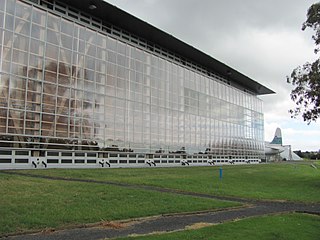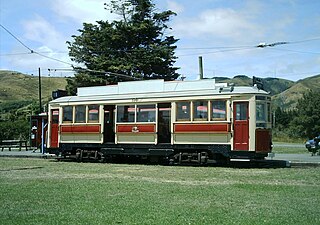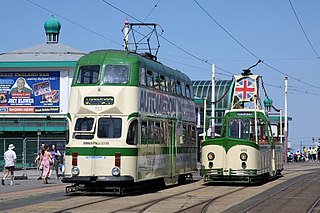
A tram is a type of urban rail transit consisting of rail vehicles, either individual railcars or self-propelled trains coupled into multiple units that run on tramway tracks on urban public streets; some include segments on segregated right-of-way. The tramlines or networks operated as public transport are called tramways or simply trams/streetcars. Many recently built tramways use the contemporary term light rail.

The Museum of Transport and Technology (MOTAT) is a science and technology museum located in Western Springs, Auckland, New Zealand. It is located close to the Western Springs Stadium, Auckland Zoo and the Western Springs Park. The museum has large collections of civilian and military aircraft and other land transport vehicles. An ongoing programme is in place to restore and conserve items in the collections. This work is largely managed by volunteers but, since the passing of the Museum of Transport and Technology Act in 2000, has been supported by full-time professional museum staff. New public programmes and facilities now promote the collections.

The Wellington tramway system (1878–1964) operated in Wellington, the capital of New Zealand. The tramways were originally owned by a private company, but were purchased by the city and formed a major part of the city's transport system.

A double-decker tram or double-deck tram is a tram that has two levels or decks. Some double-decker trams have open tops. Double-deck trams were once popular in some European cities, like Berlin and London, throughout the British Empire countries in the early half of the 20th century including Auckland, Christchurch and Wellington in New Zealand; Hobart, Tasmania in Australia and in parts of Asia. They are still in service or even newly introduced in Hong Kong, Alexandria, Oranjestad, Blackpool, Birkenhead, Franschhoek, Auckland and Douglas, mostly as heritage or tourist trams.

The Grimsby & Immingham Electric Railway (G&IER) was an electric light railway, primarily for passenger traffic, linking Great Grimsby with the Port of Immingham in Lincolnshire, England. The line was built by the Great Central Railway (GCR), was absorbed by the London & North Eastern Railway (LNER) in 1923, and became part of the Eastern Region of British Railways. It ran mainly on reserved track.
This is a list of jargon commonly used by railfans and railway employees in New Zealand.

The Brisbane tramway network served the city of Brisbane, Australia, between 1885 and 1969. It ran on standard gauge track. The electric system was originally energised to 500 volts, and subsequently increased to 600 volts. All tramcars built in Brisbane up to 1938 had an open design. This proved so popular, especially on hot summer nights, that the trams were used as fundraisers and often chartered right up until the last service by social groups.
This list collects the transport-related vehicles exhibited or owned by the Museum of Transport and Technology (MOTAT) in Auckland, New Zealand.
The history of trams, streetcars, or trolleys began in the early nineteenth century. It can be divided up into several discrete periods defined by the principal means of motive power used.

The Christchurch tramway system was an extensive network in Christchurch, New Zealand, with steam and horse trams from 1882. Electric trams ran from 1905 to 1954, when the last line from Cashmere to Papanui was replaced by buses.

Trams in New Zealand were a major form of transport from the 19th century into the mid-20th century. New Zealand's first (horse) tramway was established in 1862 (Nelson), followed by a steam tramway in 1871 (Thames), and the first electric tramway in 1900. In New Zealand railway terminology a bush tramway is an industrial tramway, which usually did not carry passengers.

The W-class trams are a family of electric trams built by the Melbourne & Metropolitan Tramways Board (MMTB) between 1923 and 1956. Over the 33 years of production, 752 vehicles spanning 12 sub-classes were constructed, the majority at the MMTB's Preston Workshops.

In New Zealand railway terminology, a bush tramway is an industrial tramway, most commonly used for logging. They are distinguished from urban trams as bush tramways were predominantly for freight, usually logging in the bush, and not for passengers, and were often built in parts of the countryside that were otherwise inaccessible to transport. In some cases, such as the Kinleith Branch, bush tramways were converted to heavy rail and incorporated into the New Zealand Government Railways network. In modern parlance, both urban trams and bush tramways are known as light rail.

The earliest trams in Australia operated in the latter decades of the 19th century, hauled by horses or "steam tram motors". At the turn of the 20th century, propulsion almost universally turned to electrification, although cable trams lingered in Melbourne. In cities and towns that had trams, they were a major part of public transport assets.
The Tramway Historical Society Inc. is located at the Ferrymead Heritage Park in the Christchurch, New Zealand suburb of Ferrymead and operates the standard gauge Ferrymead Tramway. Trams have operated at Ferrymead since 1968, with progressive extensions built between 1970 and 1984 allowing trams to operate within the boundaries of the Heritage Park. The Society also operates and own a collection of historic trolley buses and diesel buses.

Blackpool Heritage Trams are a mixed fleet of restored vehicles that run on the Blackpool Tramway, which runs from Blackpool to Fleetwood on the Fylde Coast in Lancashire, England. The line dates back to 1885 and is one of the oldest electric tramways in the world. It is operated by Blackpool Transport (BT) and is the last surviving first-generation tramway in the United Kingdom. Excluding museums, it is one of only a few tramways in the world to still use double-decker trams.
Trams have been used since the 19th century, and since then, there have been various uses and designs for trams around the world. This article covers the many design types, most notably the articulated, double-decker, drop-centre, low-floor, single ended, double-ended, rubber -tired, and tram-train; and the various uses of trams, both historical and current, most notably cargo trams, a dog car, hearse tram, maintenance trams, a mobile library service, a nursery tram, a restaurant tram, a tourist tram, and as mobile offices.











